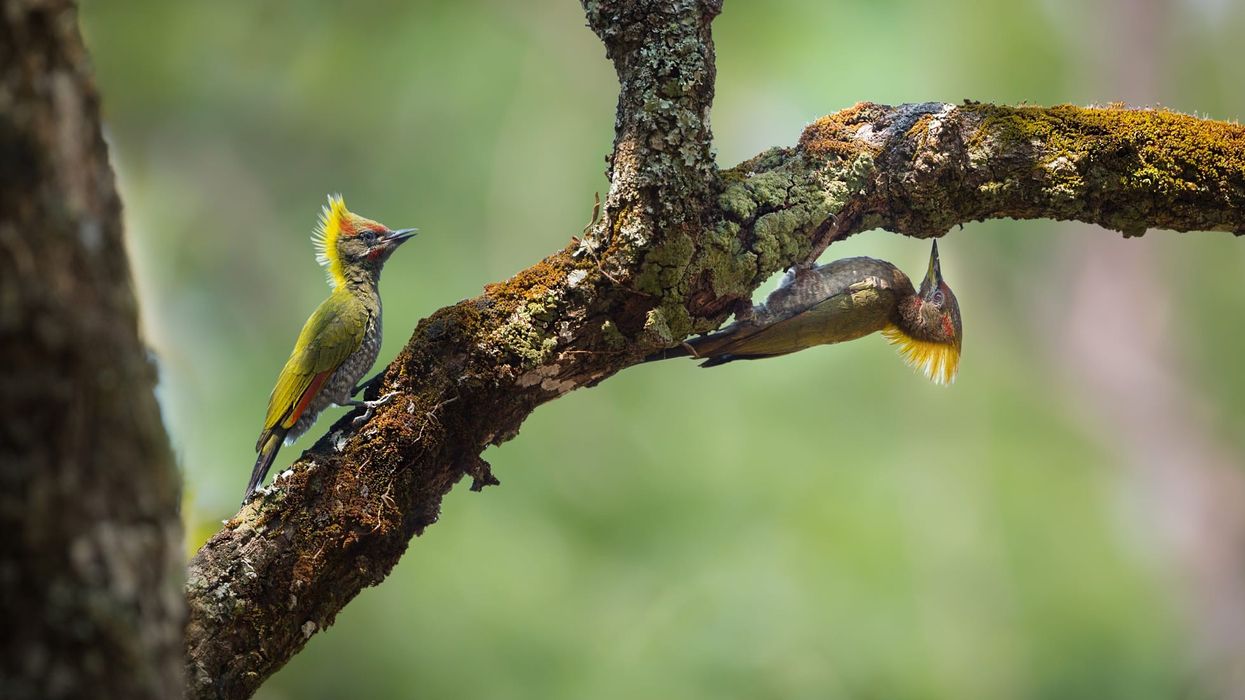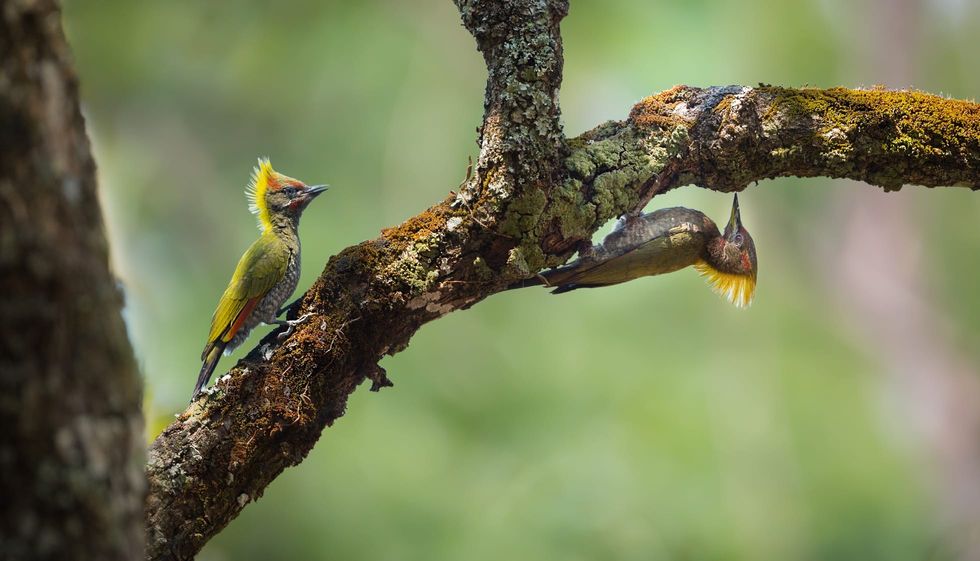We don't often see green birds, especially woodpeckers, however, the lesser yellownape is a beautiful green woodpecker that is most often found cooped up in a tree hole! If you are on a canopy tour in India and notice a lot of tree cavities, this could be the work of this bird.
In 1818, a French ornithologist named Vieilliot coined the species' name. Its scientific name, Picus chlorolophus, is a combination of Latin and Greek words that mean 'woodpecker', 'yellow', and 'crest'.
If you are someone who loves birds check out these articles for more amaze-wing facts about the flammulated owls and whiskered screech owls.
Lesser Yellownape Interesting Facts
What type of animal is a lesser yellownape?
The lesser yellownape is a type of bird. It is a woodpecker that belongs to the family Picidae.
What class of animal does a lesser yellownape belong to?
The Picus chlorolophus is a member of the class Aves and the Animalia kingdom.
How many lesser yellownapes are there in the world?
The precise population size of this bird species is not quantified. They are spread across a wide range and their population is stable and not threatened.
Where does a lesser yellownape live?
The lesser yellownape's range extends throughout the Himalayas, Bangladesh, Nepal, and Bhutan. These birds are distributed across tropical regions of Asia but are most often seen in the northern parts of India. It is said to be a common breeder in the hills of India.
What is a lesser yellownape's habitat?
The typical habitat of Picus chlorolophus birds includes evergreen and deciduous woods. They are often found roosting among flowers, tree trunks, and the branches of damp forests after fragging. They also usually dwell in vegetation-covered foothills.
Who do lesser yellownapes live with?
This jungle species lives in pairs. It also lives in flocks with other members of its species in the same territory and regularly joins mixed-species to live in the same zone. This bird guards its area fiercely and even goes to the extent of fighting any animal that enters its zone.
How long does a lesser yellownape live?
The number of years up to which these birds live is not identified. It is said that the longevity of this species depends on their size to a great extent.
How do they reproduce?
The Picus chlorolophus reproduces by laying eggs during the breeding season. This occurs from February to July in India. They lay three to four eggs that are white in color within a tree hole.
The incubation and fledging periods are unknown. Both male and female birds participate in incubation, however, the male is the food collector while the female protects the eggs. Once the eggs hatch, both adult birds feed the hatchings by the regurgitation of previously consumed food.
What is their conservation status?
As per the IUCN Red List, the conservation status of this species is Least Concern. It is predicted that there will only be a 10% decline or less in their population over the next 10 years.
Lesser Yellownape Fun Facts
What do lesser yellownapes look like?
One of the main things that make the Picus chlorolophus bird captivating is its bright yellow nape. The feathers, upperparts, bosom, and neck of this woodpecker are green. They possess a typical woodpecker shape body and bill.
Their stomach contains brown and white markings and the scruff of the neck is tawny in color. A mature male bird has a green head and a white neck along with crimson mustache stripes and scarlet patches far from each eye.
Only a red spot over the ear coverts distinguishes females. The tail is black. Hatchlings and females look alike except the young birds are a bit dull in color.
How cute are they?
These birds with their colorful and appealing nape are cute to watch. They are very good posers too!
How do they communicate?
This species communicates using calls. These calls are repetitive during the rainy and breeding seasons. Their call is a loud single note that sounds like 'peeeyaah'.
How big is a lesser yellownape?
A lesser yellownape woodpecker is 10-11 in (25-28 cm) long. This bird is five times bigger than the bee hummingbird.
How fast can a lesser yellownape fly?
The precise speed at which these birds travel is unknown. There is a scarcity of information about their flight speed. All that is known is that the Picus chlorolophus has a sloppy wing beat coupled with rare glides now and then.
How much does a lesser yellownape weigh?
This is a small bird that weighs around 2-3 oz (57-83 g).
What are their male and female names of the species?
Male and female Picus chlorolophus birds have minor morphological variations, like the red patch above the ear coverts found only in females. However, they are not given distinct names. Both birds are simply known as lesser yellownape woodpeckers.
What would you call a baby lesser yellownape?
Young or juvenile yellownapes can be called hatchlings.
What do they eat?
The lesser yellownape consumes a fair amount of ants, beetles, and larvae. It enjoys nectar and fruit much like any other woodpecker and it forages insects on the forest floor.
This is done either alone or in pairs. On several occasions, you may see this jungle species in a flock with their own species or with other species of woodpecker, babbler, and other birds that enjoy the same diet. Foxes, bobcats, coyotes, and hawks are major threats to this bird.
Are they friendly?
While this species does not pose a threat to humans, they are also not friendly either. This free-roaming bird is a scavenger. Even though they have no history of human attacks, they are quite averse to human contact and may attack if disturbed.
Would they make a good pet?
It is illegal to keep woodpeckers as pets in several parts of the world and they aren't widely available in pet stores. They are untamable birds who should be left alone in their natural habitat.
Did you know...
In Greek folklore, there is an interesting story about the name of this bird. Picus was the son of Saturn. Circe, a sorceress, fell head over heels in love with him, but he turned her down since he was engaged to Cannes. Circe then cast a spell turning Picus into a woodpecker!
This green bird that nests in a tree matches well with the deciduous forest it lives in, giving it excellent camouflage abilities. While pecking the bird uses its tail as support against tree branches.
Among Gujaratis, this bird is commonly referred to as 'lilo lakkad khod', which translates to 'green woodpecker'. In Hindi, this bird species is called 'choti pili guddi ka kathfoda' which means 'tiny yellow crowned woodpecker'.
Lesser yellownape vs greater yellownape
Both of these birds are members of the Picidae family, with the lesser yellownape belonging to the Picus genus and the greater yellownape belonging to the Chrysophlegma genus. The Chrysophlegma species was thought to be part of the Picus genus until research in 2008 revealed that they were from two separate genera.
Lesser and greater yellownape woodpeckers are closely related though, with minor variations that tell them apart. They are both the same color, but the former is distinguished by white and brown blotches on the belly.
It also has a crimson smear above its eye. This bird's beak is blackish gray.
The greater yellownape is noticeably larger, with a pale green stomach that lacks markings. It doesn't have a crimson smear and its bill is white in color.
How many subspecies of lesser yellownape are there?
The lesser yellownape bird family has six identified subspecies in the world. The range of distribution of all these species differs. Picus chlorolophus chlorigaster was discovered in pre-insular India.
Picus chlorolophus chlorolophus is a subspecies of Picus chlorolophus that is found in Nepal, Myanmar, and Vietnam. Citrinocristatus picus chlorolophus has been spotted in northern Vietnam and China.
Simlae picus chlorolophus is a woodpecker that is widespread in Himachal Pradesh. Picus chlorolophus wellsi (Picus chlorolophus wellsi) is a fall breeder that is mostly seen within Sri Lanka. Finally, Picus chlorolophus longipennis nests in Hainan and the southeastern region of China.
Here at Kidadl, we have carefully created lots of interesting family friendly animal facts for everyone to discover! Learn more about some other birds from our myna bird facts and flame bowerbird facts pages.
You can even occupy yourself at home by drawing one of our free printable lesser yellownape coloring pages.
Thank you to Kidadler Dhruv Swamini for providing the image of Lesser Yellownape in this article.









